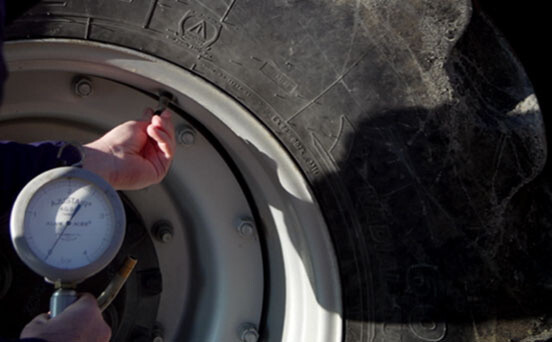
Agricultural tire storage
Tire storage: How do you store ag tires correctly?
As a farmer, you probably have several tractor tire mountings for the same tractor – each for different functions (plowing, treatment, sowing). Whenever you need to dismount one set of tires to replace it with another for a specific job, you must store the dismounted set. Here are our recommendations for tire storage.
SUMMARY:
How to handle agricultural tires
Before talking about tire storage, it's important to address how to handle tires properly. The process of moving tires means you will be moving considerable weight – up to 700+ lbs (350 kilos) with rims included. It’s important to take precautions to avoid injury when moving that amount of weight.
To ensure safe handling of dismounted wheels, we recommend using appropriate equipment, such as a wheel carrier. We also recommend that you wear protective gloves when handling tires.
Recommendations for ag tire storage
Before storing your ag tires, it is recommended you pressure wash them, so they’re clean of any dirt or other elements that could degrade the rubber over time.
Now let's get to the heart of the matter: proper tire storage.
Tractor tires must be stored in clean conditions, in dry, well-ventilated locations, away from direct sunlight. This prevents premature degradation of the rubber.
Proper farm tire storage also requires keeping tires away from other elements that can prematurely degrade them:
- sources of ozone (electric motors, transformers, arc welding stations, etc.),
- any chemical substance, solvent or hydrocarbon that could alter the nature of the rubber,
- any objects that could pierce the rubber (sharp or pointed metal objects, etc.),
- Flames or hot objects.

Closeup of ag tires with dirt and hay on them
Other important advice
-
Never store bare tires or fully assembled off-vehicle wheels in direct contact with the ground for long periods. To help them avoid differences in humidity, place them on something, such as a wooden board or plastic sheeting.
-
When the tires are on rims, you can store them either in stacks or vertically. If storing them vertically, be sure to apply pressure to the tires to prevent them from being crushed, which would eventually deform them.
Winter tire storage
While winter tire storage involves the same precautions as tire storage during warmer times, (keep tires out of direct sunlight, in a dry, well-ventilated place, away from all chemical substances, sources of heat and sharp objects), there are additional things to consider to keep the tires fitted:
- To avoid tires from being crushed, we recommend removing as much weight as possible from the machine, starting with removable tools, and putting +0.5 bar more pressure in the tires than the recommended pressure.
- In addition, to minimize 'flat spotting' (when the tire flattens slightly on the part in contact with the ground after wintering), the trick is to move the machine once a month so that the wheels turn a quarter turn.
How to put farm tires back into service
When the tire storage period is over, it is essential to adjust your tire pressure back to the recommended pressure so they will support the activity you need to perform.
Always refer to the Michelin inflation chart to determine the correct pressure for your ag tires. You can also read our article "What is the correct tractor tire pressure?"

Adjusting the tire pressure of a farm tire
Don't forget that:
- Under-inflation causes the casing to become exaggeratedly misshapen and will shorten the tire's service life.
- Over-inflation reduces the surface area in contact with the ground, causes a loss of grip, and makes the tire more sensitive to impacts and cuts.
If loads are less weight than those shown in our pressure/load charts, never adjust your tractor tire pressure to lower than the minimum pressure shown in the tire datasheets.
End of wintering
When harvest time arrives, it's time to put your combine harvester back into service. To find out how to prepare your tires properly, read our article "How to adapt your combine harvester tires".
Other help and advice pages that might interest you:
Need more advice? Discover our tyre maintenance and caring guide




